Rumors, Stories, & Interviews
Let me know you what you think or send in a story, double click -> Newsletter Opt-In Email (Click Here)
"Scroll Down"
Rumors,
Stories, & Interviews
![]()
Let me know you what you think or send in a story,
double click ->
Newsletter Opt-In Email (Click Here)
![]()
![]()
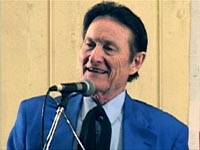 |
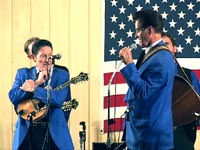 |
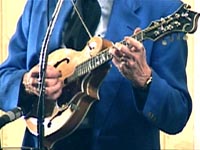 |
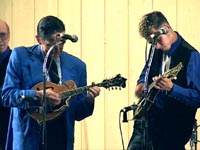 |
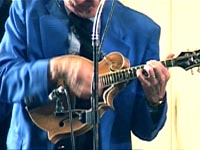 |
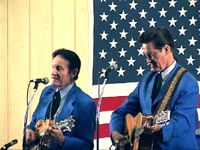 |
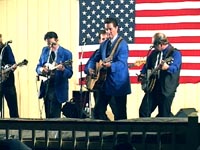 |
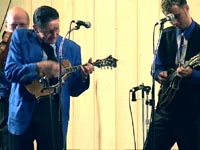 |
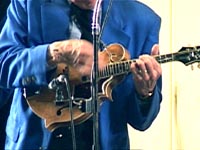 |
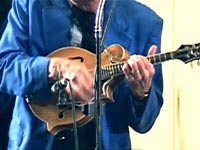 |
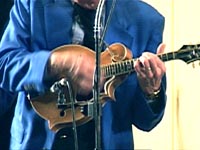 |
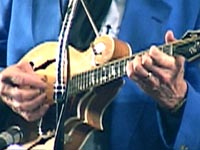 |
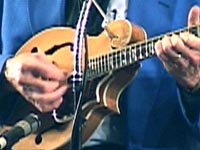 |
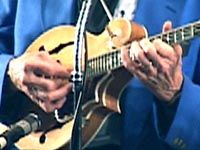 |
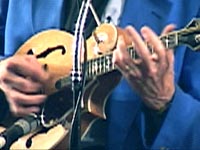 |
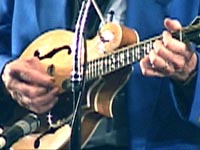 |
A extended interview with Jesse
McReynolds
conducted by Jim Moss 2-7-99: Part
1
![]()
For Reference I have listed the earlier parts:
A extended interview with Jesse
McReynolds Part 2
http://www.candlewater.com/interviews/Jesse_Part2/
A extended interview with Jesse
McReynolds Part 3
http://www.candlewater.com/interviews/Jesse_Part3/
A extended interview with Jesse
McReynolds Part 4
http://www.candlewater.com/interviews/Jesse_Part4/
![]()
NOTE: If
permission to reprint this is granted by owner, each part must presented
in its entirety with the "by line" and URL
"www.candlewater.com"
Jim Moss: You're known for creating one of the
dominant styles of mandolin
in Bluegrass, and... that really stands for
something in a lot of ways in that you
innovated, right?
Jesse McReynolds: Well, I... tried to create
something a little bit different than
anybody else had done. I like to play... whatever I
play I want to do it... something my own way.
That is just something I like to do. I never
did like to copy what someone else had done.
Jim Moss: Right, so let me ask you, before you
did this innovation you had been playing
and playing in the Bluegrass - brother harmony environment
right?
Jesse McReynolds: Yes, I had played... I
played mandolin when we started out in 1947...
I played straight mandolin then, like Bill Monroe...
We listened to the Blue Sky Boys, Red Rector.
Red Rector was a big influence on me for playing back
then, you know.
Jim Moss: Hmmm.... Red Rector influenced you?
Jesse McReynolds: I don't know if Red ever got
the credit he deserved as a mandolin player, but
he was... back in the days of Jethro Burns and ah.. quite
a few of the others. up around Knoxville you know?
Paul Buskirk he was down in Houston. He was a great
mandolin player. He played some... the same type
that Jethro did you know.
Jim Moss: Buskirk?
Jesse McReynolds: Paul Buskirk, yeah. He
has been on the Austin City Limits a lot with Willie Nelson
and Johnny Gimble and a bunch of them. Plays guitar
and the mandolin too. Electric mandolin is what
he plays most of the time. But, I listened to a lot
of different people, back then, who played different
styles. I tried to play nearly all of them back
then.
Jim Moss: So there was a time when you played
pretty much straight ahead. Did you ever try to follow
like a Monroe style?
Jesse McReynolds: Yes, when we first started out,
we did a lot of Monroe songs, like Tennessee Blues...
or Mighty Dark To Travel... some of the things him
and Lester did you know, in the old first recordings he did.
And we kept up with his... his records and everything as
they came out. I guess that was one of my favorite
sources of playing the mandolin at that time. That was
when I was just starting and Bill Monroe's type of mandolin
was really complicated for me to learn.
Jim Moss: Yeah, it was? Yeah, the feel is..
Jesse McReynolds: Bill notes concentrates on the,
he'd concentrate on the down stroke all the time... get
more notes... out of the down stroke then... most people'd
put the up and down stroke in. That is why I
was interested in the way Red Rector would play and he'd
play the up and down. Like a hoedown type
thing.
Jim Moss: So... when you decided... was it a conscious decision to say "I want to play something different"?
Jesse McReynolds: Yeah, I had... I had heard,
after Scruggs style come out on the banjo, I sort of was
listening to what he was doing. Trying to pick out
what he was doin. I just heard it on records and radio...
and the Opry and uh. I tried to adapt that
sorta to a mandolin. I didn't know how he was doin it. I knew he
was using a three finger roll on it, but I just
decided, I was trying to do it with a straight pick so I could
play my other style too.
Jim Moss: So, when we were doing my fiddle album,
I could see that you were not only cross picking, but
you were splitting strings, and alternating between the
pairs.
Jesse McReynolds: Yeah, I do... I do a lot
of that too. That's something I just, I just learned and started
to do and uh.. I guess the first recording I
made on it was 1952 when we recorded for Capital. In fact,
the first session we did with Capital Records we did a
song called "Just Wondering Why"... and I ... did that
on it. That was the first recording I did with it.
Jim Moss: How many variations are there? How many
variations are there to your picking styles, you know
like cross picking...
Jesse McReynolds: I do cross picking, I
do... well... I do Bill Monroe some, and I do the spilt string thing.
That is what I concentrate on more as far as sitting
around, an entertain myself doing that. So, uh.. it is amazing
how you can just sit around and do things like that what
you come up with.
Jim Moss: So would you say that cross picking is less of your style than split stringing.. or...
Jesse McReynolds: No, cross picking is my main style.
Jim Moss: So within cross picking, how many variations would you think there are?
Jesse McReynolds: I would say just about as many
as there would be with the banjo... banjo pickin rolls, you know.
I do some... sort of... chromatic type things which is
more like, is not like the one down and two up stroke, its like
maybe two up, maybe two sets of strings to do it instead
of one... I mean three. So you vary from the three fingered
roll cross picking thing on three strings, back to
two. I guess you just hit a half of a roll that way, I guess is what you
say.
Then I learned a lot of notes that would go into
the... you roll out, get the roll going and start doing the chromatic
playing and uh, that is something I just worked on.
Jim Moss: So uh... let me see if I got this
straight. You would be integrating down strokes and up strokes...
and you
would be doing...
Jesse McReynolds: Well the basic cross picking
roll is down one and up two. Just a pattern, and in order to go
from one position to another sometimes you'll have to
break that roll, and you'll have to go on one down and one up
on two sets of strings in order to get back into your
pattern in another... Its hard to explain just how it is!
Jim Moss: No, I think you're doing fine. So
actually, when you think about playing a tune, it sounds like you see
yourself in patterns, working from one pattern to another
pattern.
Jesse McReynolds: Uh Huh, Yeah. Uh, I try
to stick to the melody. Whatever it takes to keep the melody of the
song going in there. I learned that from Alan
Shelton. He played banjo with us more, I guess, seven or eight years all
together.
And we use to play a lot together and we sort of...
heard music alike, but I always admired his banjo playing because
he kept the melody going on it... and playing with the
melody line, you could always hear it. So that's what I try to do
mostly on the cross picking thing.
Its hard to do without, uh... staying on the melody without breaking that roll... going how the tune goes, you know.
Jim Moss: Uh huh... This is great
stuff. It is great to hear you talking about this. So you have
described two
types of rolls. and how many types of rolls do you
think there are total?
Jesse McReynolds: Well, there's forward
rolls, backward rolls. I do the backwards roll like if you think of banjo
picking.
The one I do is like the backwards roll on the
banjo. The banjo roll is uh, lets see uh, two down and one up.
The forward roll they call it. Its uh, the third
string, then you get the second one where its the thumb string in
the banjo's case, but you get your thumb and then your
first finger and then its uh.. its two down and one up.
But I just turned it around, I do one down and two
up. It'd better for me that way... with a straight pick.
Jim Moss: What is a good example of this, where we can hear this?
Jesse McReynolds: Ahh.. You mean on a tune or something?
Jim Moss: Yeah.
Jesse McReynolds: The first tune I did was
"Are You Missing Me"... first song. I've done it a lot on
different instrumentals.
I don't know how many of my instrumental projects you've
got.
Jim Moss: uh.. I don't either, off hand. I have a bunch of your stuff.
Jesse McReynolds: On a tune like "Sweet Little
Miss Blue Eyes" and "Don't Say Goodby If You Love Me".
On the older stuff we did on Capital, some of the first
recording we did back in 52, uh I did some, it was basically
on that, that was basically straight roll all the way
through. Then I learned later to... you could break the roll and
kinda stick to the melody a little better.
Jim Moss: So you would typically use a backward roll,
and then break it up with a quarter roll, then move into
another roll.
Jesse McReynolds: Yeah...
Jim Moss: Which would be the same backward roll, typically?
Jesse McReynolds: Yeah...
Jim Moss: And where did you first hear split stringing?
Jesse McReynolds: I didn't hear that from nobody
really. I just sort of hooked onto it.
It was a slow process, and I learned how many crazy
positions you could get in and
get three part harmony and sometimes you get four.
I'm still... really... learning things on that
because when I practice I don't practice like I use to,
but when I get time to practice, I'll
just get on that and entertain myself... find how many
different positions you can do and
how many strange sounds you can get out of it that way.
Jim Moss: Yeah, I actually have a tape here of you
sitting in a trailer in 63 working out different cross picking
positions. It seems that you took quite a bit of
time practicing.
Jesse McReynolds: Well, some things, like I did
on the Mandolin Extravaganza project, Dave Grisman.. and we
did the Cajun fiddle things. And I tried to... what
I tried on there I did split string and cross picking together.
It was basically the same roll, but I did the split string
on it too.
Jim Moss: I think you did that on my album, cross picking and split stringing at the same time.
Jesse McReynolds: Yeah, I probably did.
Jim Moss: Yeah, cause I was pretty much blown
away by watching it. I mean, it is pretty incredible
to see you do this up close and see the kind of accuracy
required to get in there and get out.
Jesse McReynolds: Well, I .. uh..
appreciate any body who mentions that. I told my wife a few times,
I think I've picked myself into a category that, I don't
know if anybody wants it or not. You know they
can't figure it out. (laughs)
Jim Moss: Right, well, that's where I think an
interview like this will help, because a lot of people... I have
thousands of readers and a lot of them are mandolin
players. They want to know the in's and out's of...
Jesse McReynolds: Well, I don't know... I
just do this to satisfy my own musical taste. I never really tried
to uh...
Jim Moss: Did you ever put out a lesson tape?
Jesse McReynolds: Yeah I put out a video tape on
home spun tapes. That slipped my mind, but I guess
six or seven years ago. I was never very good
at explaining what I do as far as teaching or anything.
I'm just a musician and I play what I like to hear.
Its hard for me to explain it.
Jim Moss: I don't think that that is so
unusual. When I would be... You know I learned fiddle from Baker,
and learning from him, you have to know how to pull the
information out. I mean he was really really willing
to teach me, people, but you have to know how to ask the
question to get the... you had to pull it out, you know. (laughs)
So, being a great innovator and a great musician doesn't
really mean you're going to be a great instructor.
One thing I wanted to bring up. When we were
recording that album, you brought a fiddle, or there was a fiddle
there at the studio, and it was a Gibson fiddle with a
Virzi in it... as I remember.
("Virzi Tone Producer", product of a family of
violin makers from Sicily)
Jesse McReynolds: I don't remember that. You sure it was a fiddle?
Jim Moss: Yeah, I remember seeing a fiddle there with a
Virzi in it... and I thought you had brought it. Maybe you had
borrowed it our found it there in the studio.
Jesse McReynolds: No I didn't, unless it belong to someone else.
Jim Moss: It was very unusual. So, do you still play a lot of fiddle?
Jesse McReynolds: Well, not too much. I do
a few things with Buddy, Buddy Griffin. I quit playing fiddle for
quite a while there when Glen Duncan went to work with
us. I sort of backed off, tried to play enough mandolin
to stay with him. My wife bought me a fiddle
from, I still have my grandfather's fiddle. I got it fixed up last year.
The one he played on the original sessions with in
29. I play it some on stage, I may do one of the old tunes
he use to play.
Jim Moss: Your father was a fiddle player?
Jesse McReynolds: Yeah, he played some, my
grandfather was one. He was the one who played on the Bristol Sessions.
With uh, the Carter Family, Jimmie Rodgers and all
them. They call it the Bristol Sessions. There is a two album set
they came out with, on RCA. It was a collectors item
on the history of country music.
Jim Moss: Did you start playing fiddle first or mandolin?
Jesse McReynolds: I guess I started playing fiddle first.
Jim Moss: How old were you?
Jesse McReynolds: When I started?
Jim Moss: Yeah.
Jesse McReynolds: Oh, I got into it really, when
I was about 14 years old I was in a car accident and had my
legs broke. I like to about lost my left foot.
At that time I was laid up for about six months as far as getting out
and doing something. I started playing a lot
then. Just sitting at home trying to amuse myself.
Jim Moss: And that was your first instrument?
Jesse McReynolds: Yeah.
Jim Moss: You had a fiddle album out. You only have one right?
Jesse McReynolds: Yeah, I did one.
Jim Moss: And you wrote a lot of tunes that have become standards now.
Jesse McReynolds: Yeah, I guess the best one I
wrote as far as a standard is the Dixie Hoedown.
I did that with Vassar Clements. We did it together
on our first uh, that was on STARDAY recordings.
Vassar worked with us down in Florida and Georgia.
We did one session over in Jacksonville. Jacksonville
Florida is where we cut it at... and I had this little
tune. I was actually going to make a tune that you could
sing with on it. I ended up doing this one and we
recorded it. Its still the most popular thing I ever done,
I think.
Jim Moss: Didn't you write Stoney Creek?
Jesse McReynolds: There was another tune called
Stoney Creek I guess. I didn't realize that there was
another one, but someone else had wrote a fiddle tune
called Stoney Creek. I thought that might be the one
you were thinking of. But I had Stoney Creek on the
first uh... the Bluegrass Special album I think.
The first recording on EPIC.
Jim Moss: Was that the one you wrote?
Jesse McReynolds: Yeah.
Jim Moss: That's the one that Kenny Baker plays...?
Jesse McReynolds: Yeah. That was mine.
Jim Moss: So is your fiddle album still in print? Do you sell it?
Jesse McReynolds: Carl Wayne put that out on Attaram
Records in Atlanta?
and he, yeah he still sells some.
Jim Moss: When did you record that?
Jesse McReynolds: He has got it on CD. I don't try to sell too much. I carry some with me sometimes.
Jim Moss: When did you record that?
Jesse McReynolds: About 19.. about 1970 I guess.
Jim Moss: Ah, that late?
Jesse McReynolds: Yeah, it was after we uh, came
to Nashville, so I say uh.. We came here
in 1965, it was probably recorded close to 1970 something
like that.
Jim Moss: So your career started out in your home town then.
Jesse McReynolds: Yeah, well, our home town of
Coeburn Virginia. We started out on a radio station
in Norton which was 8 miles up the road... and they opened
up a radio station there, WNVA and we
got a 15 minute program on there. Started working
show dates.. I had to work with a few other groups...
Jim Moss: You weren't doing other work at the time?
Jesse McReynolds: Uh... I worked with a few other groups.
Jim Moss: You weren't working a day job?
Jesse McReynolds: No. I was just
home. Jim was in the Army when I first started, playing with the small
groups there.
And then when he got out of the Army why I met the guy at
the radio station in Norton, we went up there and talked
to him about getting a band together. So we got a
four piece band together and they put us on the radio. And we started
going out doing our own booking and trying to handle our
own things so we done it for 52 years.
Jim Moss: So that was 52 years ago.
Jesse McReynolds: Yeah, somewhere around there. It was 1947.
Jim Moss: When we were doing my album, there in
the studio, you were saying that it wasn't until the early 1950's
that you thought you could actually make a career out of
it.
Jesse McReynolds: Yeah, I guess it was when
we got our first recording contract on Capital, in 1952.
We went a lot of places, tried to do the same thing we did
in Norton... different radio stations. Try to get
enough money to operate on till we got bookings come
in. And in a lot of places that worked and a lot
it didn't. So a few times we had to disband... go
back home... we couldn't call many people we had to write
letters to people.
Jim Moss: So what was the situation in the
uh... I remember Baker telling me something about how radio
stations would work. The radio stations would hire
the musicians individually in a band?
Jesse McReynolds: Well, in our case, we never did
get any direct pay from any of the radio stations.
They would give us a percentage of... they call um.
CI's or something like that. Just what that would mean...
We would sell ball point pens or Quill pieces... or..
things that country people could use, you know.
and we sold a lot of... a lot of ball point pens.
Jim Moss: So you would get a percentage of the sales.
Jesse McReynolds: We would get a percentage of
what, that would be the only pay we'd get from the radio
stations. It wasn't very much.
Jim Moss: It must have taken a while to figure out who was going to buy what pens, because they didn't call up.
Jesse McReynolds: No, it was a write in thing.
Jim Moss: So back then, you would get paid a
percentage of the sales. It wouldn't be like a sponsor that would
pay you a...
Jesse McReynolds: No. No there wasn't no
sponsor back in them days. We didn't get into sponsors until
we got into television... in Georgia. We
accidentally, luck we ran into a Ford Tractor Theater down there
that buy us some TV time. That's how we got started
in television. They put us on television sponsoring on
three of four TV stations. And that's where we
started getting a little bit of money. It wasn't that much.
You might get $100 a show for the talent. Then he
had to buy the TV time. That was pretty expensive
for a company to go and buy 30 minutes of television time
and pay a band $100 more.
Jim Moss: What year was that now?
Jesse McReynolds: This was in.. uh... The late 50's
Jim Moss: uh huh.. 57 ?
Jesse McReynolds: 55 to the 60's.
Jim Moss: And so.. let me think
here. If you were getting $100, what would be a.. Do you
remember
what a quart of milk would cost back then? To give
the people a reference of what $100 bought back then.
Jesse McReynolds: about half.. it would be less than half of what you get for it now I would guess.
Jim Moss: You think maybe 10 cents a quart?
Jesse McReynolds: I'd say, oh I guess it would be about 25 or 30 cents a quart.
Jim Moss: It gives people some idea, when you say $100 what it means.
Jesse McReynolds: Well, you go back..
You now how high prices went up during the energy crisis a
few years back
Jim Moss: 73... 74...
Jesse McReynolds: That's when everything
doubled. We use to buy gasoline for under 20 cents a gallon.
We use to by diesel fuel for 13 or 15 cents a gallon.
Jim Moss: Yeah, you know, I don't want to hear
any complaints about gasoline, you guys are playing
around 91 cents a gallon out there and we playing about
$2.00 out here.
Jesse McReynolds: Is that right?
Jim Moss: Yeah!
Jesse McReynolds: I guess its fixing to go up too, ain't it?
Jim Moss: I know at Bean Blossom I almost had a heart
attack it was 90 cents, 91 cents and you
talk to people out here and they are amazed.
Jesse McReynolds: We were out there at
Norco and we leased a car and we found out what the
difference is.
Jim Moss: So getting back to the stations again.
When you would work with other bands would you
work at radio stations?
Jesse McReynolds: No, back then I worked with,
the guy his name was Roy Sykes. Carter Stanley
worked some with him too... before Ralph. Ralph was
in the service at that time too. Carter worked
with these guys. Guy who had a band and would go
around and book. That's how I learned a lot about
how a band would operate. It started off you'd have
to go... just go out to the country and finding
little towns. Go to the school house and
school principle and try to get him to give you a date when
you could work the school. You did everything and
give them like 30 % of what was taken in. Everything
was all percentage back then. and when we ended
up... settle up... why what was left after expense
of getting there make it 4 ways or how many people's in
the band you know.
Jim Moss: So he would subtract your expense to get there first.
Jesse McReynolds: Yep. I
wasn't... I wasn't making much money, but I was staying home. We
might
go out on the weekends and play, go down to Kentucky, play
for a couple of days then he'd bring me
back home and wait till he got a few more dates. It
wasn't no regular thing.
Jim Moss: So over the years you have worked a
lot, then a little, then a lot... Your style was a little off to
the side of hard core traditional Monroe style
Bluegrass for a lot of the time, because you did some country songs.
Jesse McReynolds: Yeah, we did. I think we went
to... Now lets see, let me think just when this was, about 1950
we went to uh, get a job... We did get a paying job
in a radio station in Wichita, Kansas, but we had to do
Western music. It wasn't Jim & Jesse then.
That was before we started recording. It was, uh... KFBI Ranch Boys.
And we had a accordion and a steel guitar, mandolin,
guitar and bass.
Jim Moss: Now was this an electric mandolin ever?
Jesse McReynolds: No, just a regular mandolin.
Jim Moss: So you always played an acoustic mandolin.
Jesse McReynolds: Well, I recorded some projects
with electric mandolin.
To be continued
Click Here To
Return To Bluegrass Menu Page
CLICK
HERE TO: Return To PHOTO Page Listings
CLICK
HERE TO: Return To The INTERVIEW Listings
![]()
![]()
Again, your
comments and suggestions are encouraged.
BOOKMARK THIS SITE ! ...then get on the email list
Newsletter Opt-In Email (Click Here)
Click Here To Return The Jim Moss Bluegrass & Swing Fiddle web site.
![]()
| All Rights Owned by Mossware
LLC. Any use of these materials must be approved of in advance and in writing. |